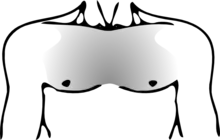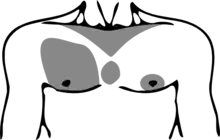Chest hair
Chest hair is hair that grows on the chest in the region between the neck and the abdomen. Chest hair develops during and after puberty along with other types of androgenic hair.

Development and growth
Although vellus hair is already present in the area in childhood, chest hair is the terminal hair that develops as an effect of rising levels of androgens (primarily testosterone and its derivatives) due to puberty. Different from the head hair, it is therefore a secondary sexual characteristic. Men tend to be covered with far more terminal hair, particularly on the chest, the abdomen, and the face.
The development of chest hair begins normally during late puberty, usually between the ages of 12 and 18. It can also start later, between the age of 20 and 30, so that many men in their twenties have not yet reached their full chest hair development. The growth continues subsequently.
Patterns and characteristics
The individual occurrence and characteristics of chest hair depend on the genetic disposition, the hormonal status and the age of the person. The genes primarily determine the amount, patterns and thickness of chest hair. Some men are very hairy, while others have no chest hair at all. All ranges and patterns of hair growth are normal. The areas where terminal hair may grow are the periareolar areas (nipples), the centre and sides of the chest and the clavicle collarbone.
The direction of growth of hair can make for interesting patterns, akin to depictions of mathematical vector fields. Typical males will exhibit a node on the upper sternum, the hair above which points up and the hair below which points down. Some individuals have spirals on their upper pectoral regions (several inches from the nipple towards the neck) which run clockwise on the left breast and counter-clockwise on the right.
Considering an individual occurrence of chest hair as abnormal is usually not due to medical indications but primarily to cultural and social attitudes. An excessive growth of terminal hair on the body of men and women is called hypertrichosis. This medical term has to be distinguished from hirsutism that just affects women. These women can develop terminal hair on the chest following the male pattern as a symptom of an endocrine disease.
Setty patterns

There have been occasional studies documenting patterns of chest hair in men and occurrence of these patterns. A study of 1,400 white men aged 17 to 71 conducted by L.R. Setty in the 1960s defines 15 patterns of chest hair.[1][2][3][4] In this study, four parts of the chest in which terminal hair occurs were identified:
| Area | Description | Incidence[2] |
|---|---|---|
| Sternal | The center and lower part of the body of the breastbone | 74% |
| Infraclavicular | The area immediately below the medial end of the collarbone; | 63% |
| Pectoral | The breast area, including the area immediately around the areola (nipples); | 77% |
| Circumareolar | A small area immediately encircling the areola. | 16% |
Chest hair may occur on each of these areas independent from the others, making for a total of 15 combinations in addition to the apilose (bare) pattern. Hair is said to occur on both the pectoral and circumareolar areas when there is hair around the nipples and on the breast, but these areas are not connected.

A |

C |

CI |

CS |

CP |

CPI |

CPS |

CPSI |

CSI |

I |

P |

PI |

PS |

PSI |

S |

SI |
| The 16 chest hair patterns by Setty | |||
| Pattern | Name | Incidence[2] |
|---|---|---|
| A | Apilose | 6% |
| C | Circumareolar | 6% |
| CI | Circumareolo-infraclavicular | 1.5% |
| CP | Circumareolo-pectoral | 0.1% |
| CPI | Circumareolo-pecto-infraclavicular | 0.1% |
| CPS | Circumareolo-pecto-sternal | 0.1% |
| CPSI | Circumareolo-pecto-sterno-infraclavicular | 0.1% |
| CS | Circumareolo-sternal | 5% |
| CSI | Circumareolo-sterno-infraclavicular | 2% |
| I | Infraclavicular | 0.5% |
| P | Pectoral | 5% |
| PI | Pecto-infraclavicular | 1.5% |
| PS | Pecto-sternal | 13% |
| PSI | Pecto-sterno-infraclavicular | 57% |
| S | Sternal | 1.7% |
| SI | Sterno-infraclavicular | 0.1% |
The pecto-sterno-infraclavicular pattern, in which the breast, sternum and medial end of the clavicle is covered with terminal hair, is most common (57%).
Examples of patterns
 CS – Chest hair primarily on sternum and around the nipples
CS – Chest hair primarily on sternum and around the nipples PS – Chest hair on sternum and breast
PS – Chest hair on sternum and breast PSI – Hair on sternum, breast and medial end of clavicle
PSI – Hair on sternum, breast and medial end of clavicle
See also
References
- Setty, LR (1961). "The Distribution of Chest Hair in Caucasoid Males". American Journal of Physical Anthropology. 19 (3): 285–7. doi:10.1002/ajpa.1330190309. PMID 13910982.
- Setty, LR (1965). "Variations of the hair patterns of the chest of white males". Journal of the National Medical Association. 57 (3): 211–4. PMC 2610947. PMID 5859933.
- Setty, LR (1963). "The circumareolo-pectoral series of chest hair patterns". Journal of the National Medical Association. 55 (3): 233–4. PMC 2642024. PMID 13988215.
- Setty, LR (1962). "The sterno-infraclavicular chest hair pattern". Journal of the National Medical Association. 54 (4): 486–7. PMC 2642315. PMID 13910983.
Further reading
- Setty, LR (1961). "Bare areas in regions of pilosity of the chest and abdomen". Journal of the National Medical Association. 53 (4): 394–5. PMC 2641808. PMID 13750402.
- Lookingbill, DP; Demers, LM; Wang, C; Leung, A; Rittmaster, RS; Santen, RJ (1991). "Clinical and biochemical parameters of androgen action in normal healthy Caucasian versus Chinese subjects". The Journal of Clinical Endocrinology and Metabolism. 72 (6): 1242–8. doi:10.1210/jcem-72-6-1242. PMID 1827450.